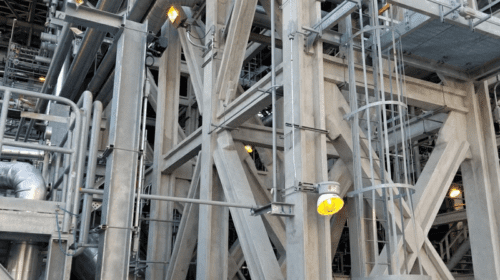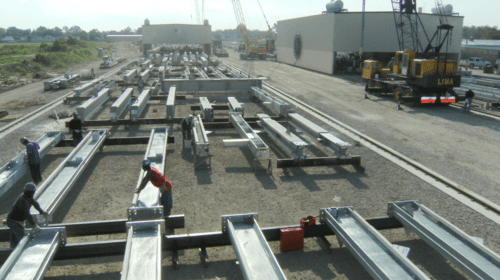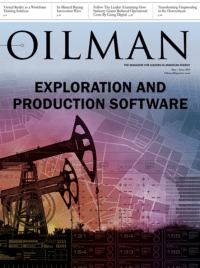In the event of a hydrocarbon plant fire, unprotected structural steel will only last a few minutes before it collapses. Whether it is a pipe rack or vessels, heat could lead to the catastrophic collapse of the structure, making it crucial to protect it. Various fireproofing systems have been utilized over many years to protect these steel structures. Surprisingly, there are currently no laws making it mandatory that petrochemical companies fireproof their steel, but for the most part, they all do it for practical purposes. Because it just makes sense to protect your assets.
Alfred Miller Contracting (AMC), headquartered in Lake Charles, Louisiana has been in business over 70 years and they fireproof more steel than anyone in North America. At their yard, they boast a highly efficient, climate-controlled fireproofing shop featuring two, 6,000 square-foot, moving buildings—rather than move the steelwork, they move the process over the steel. Their Toyota-esque Lean Production System enables them to process over 1,000 tons worth of steel at any given time and continue working in any conditions.
The idea of the moving buildings was born in 2006 with the Motiva project. At the time, it was the first mega-project and the largest in the gulf coast region. AMC had to figure out a way to supply that volume of fireproofing because it had never been done before in such a tight schedule. They followed the lean manufacturing principles modeled after Toyota, which provides the best quality, lowest cost and shortest lead time through the elimination of waste. They have several patents relating to fireproofing including a patented, UL certified corner bead which increases accuracy and productivity at the same time.
There are three different ways to fireproof steel and the one used depends on the preference of the client and the requirements of the project. There are concrete, light-weight cementitious and epoxy intumescent applications.
- Concrete: 2-inches thick, heavy, no UL certification.
- Lightweight Cementitious: ~1-inch thick, lighter weight, less durable, economical.
- Epoxy Intumescent: ~3/8-inch thick, reacts with heat to create a foam, which protects steel from heat source, durable but expensive.
As previously stated, there are no standards and/or regulations on fireproofing making it mandatory that certain guidelines are put in place and followed to avoid potentially hazardous and expensive mistakes. There is a network of people that are passionate about maintaining the integrity of fireproofing standards and in 2016 they formed an organization called PFPNet. PFPNet is a non-profit, subscription-funded body that was established to increase understanding and raise competency across the whole hydrocarbon passive fire protection industry. They do this by bringing in industry experts to consolidate their experiences to determine the best practice for application methods and the appropriate resources to use.
Simon Thurlbeck, one of the Founders of PFPNet and now Director, explains, “Having worked in the field of fire and explosion risk management in major hazard facilities for many years, it was obvious that those involved with hydrocarbon PFP needed a collective technical organization to identify and capture good practice, and produce guidance and training that the whole industry could endorse. The idea was born from a realization that the industry was asking the same questions that have always been asked, and often making the same mistakes, and that this experience was being lost as people moved on or retired, In setting up PFPNet we wanted to rectify this situation, and have industry identify the issues and provide the expertise that we could then capture through work programs voted for by the Members.”
Bob Pool, AMC’s Executive Vice-President is on the steering committee for PFPNet and was recently elected to the board of directors for the National Fireproofing Contracting Association. Because of Bob’s experience and associations within the industry, AMC has a resident fireproofing expert on hand and available to them at all times.
“Fireproofing is a permanent part of the structure and you only get one chance to do it right, so we’ve invented and tested several innovative systems which all help improve the accuracy and efficiency of the fireproofing. The consequences of getting it wrong are extremely high, so you want to make sure it is applied by applicators who understand the right fireproofing system for the situation and know how to do it correctly,” says Pool.
The fireproofing effectiveness is tested at UL (Underwriters Laboratories) in Northbrook, Illinois. In a protected facility, fireproofing products with different thicknesses are applied to mimic what is applied to the structural steel on real world projects. They run fire tests to establish the exact time before structural failure occurs. This provides the industry a realistic expectation of protection that they can offer their clients.
AMC is a company that never rests and sees itself as a solutions provider. By no means will you ever catch their president, Philip Miller, letting the grass grow under his feet. Whether it’s precast buildings, pipe racks or fireproofing, Miller believes that there is always a way to make something more efficient and more cost effective. The innovation truly never stops and Alfred Miller Contracting is revolutionizing, not just the fire proofing industry, but the entire petrochemical industry as a whole.
Photos courtesy of Alfred Miller Contracting
Sarah Skinner is a graduate of Louisiana State University with a degree in English. She has been a technical writer and editor in the oil and gas industry for over ten years in Houston and in Louisiana. She currently works as a technical writer for a pre-cast concrete construction company in Louisiana that builds blast-proof buildings for petrochemical plants.









